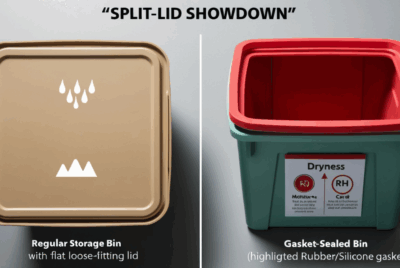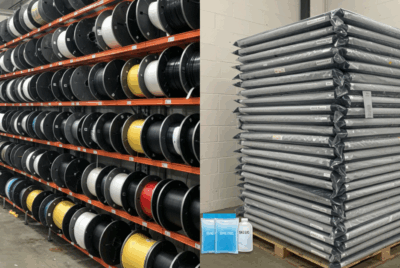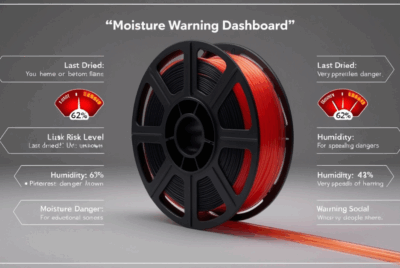Temperature Control for 3D Filament: Why It Matters?
Ever try to print something only for the result to look like spaghetti gone wrong? You might be blaming the printer, but the real culprit could be your filament storage.
Let’s dive into the art of storing 3D filament. Because if you don’t treat it right, your filament won’t return the favor.
What Happens When Filament Isn’t Stored Properly?
Think of filament like dry pasta. Leave it out in the open, and it absorbs moisture and gets ruined. The same thing happens to your filament—it gets brittle, soggy, or both. And that means…
- Failed prints
- Clogged nozzles
- Weird stringing
- Poor adhesion
Basically, a printing nightmare.
Why Moisture is Your #1 Enemy
Moisture is like kryptonite for filament. It seeps in, hides in the plastic, and waits to ruin your day.
When you heat filament that’s absorbed moisture, tiny steam bubbles form. These cause popping, poor layer bonding, and uneven extrusion. Not pretty.
Meet the Villains: Heat, Light, and Humidity
It’s not just moisture. Filament has three main enemies:
- Heat: Makes it soft or deform early.
- Light (especially UV): Breaks down the material structure.
- Humidity: The silent destroyer.
Storing filament correctly means shielding it from all three.
How to Store 3D Filament the Smart Way
Let’s break down the steps to proper filament care.
Step 1: Use Airtight Containers
Get a solid, sealed plastic bin. Bonus points if it has a gasketed lid.
🛠 Tip: Label your spools by type and date added. Organization = less frustration.
Step 2: Don’t Forget the Desiccants
Silica gel packs are a must. Toss in a few with your filament and swap them out every couple of weeks.
Step 3: Store in a Cool, Dark Place
A storage cabinet or under-bed drawer works wonders. Just make sure it’s away from heat and sunlight.
Step 4: Consider Vacuum-Sealing
Want to go pro-level? Get a food-grade vacuum sealer. It’s like cryo-sleep for your filament—preserved and ready when you are.
What Filament Types Need the Most Care?
Not all filaments are equally needy. Here’s who needs the most TLC:
PLA
- Easygoing but still hates humidity.
- Store it airtight with desiccants.
ABS
- Sensitive to UV and warping.
- Loves a dark, dry home.
Nylon
- Extremely hygroscopic (moisture magnet!).
- Needs vacuum-sealing or a filament dryer.
TPU
- Flexible and fun, but also moisture-sensitive.
- Store cool and sealed.
Best Tools for Filament Storage (Top Brands)
Want to take things up a notch? These tools are worth the investment.
1. eSUN eBox Lite
- 🔥 Heats, dries, and stores filament.
- Has a built-in spool holder.
2. Polymaker PolyDryer
- Reliable drying with adjustable temps.
- Transparent chamber for easy monitoring.
3. PrintDry Pro
- Holds multiple spools.
- Great for serious print farms.
4. SUNLU Filament Dryer Box S2
- Affordable and efficient.
- Works for 1.75mm and 2.85mm filament.
5. Wham Bam Slap Mat & Storage System
- Combines storage and workspace cleanup.
- Ideal for makers who hate mess.
DIY Solutions: Budget-Friendly Storage Hacks
Don’t want to spend big? Try these:
- Reuse large ziplock freezer bags + desiccants.
- Upcycle food-grade containers (coffee tubs, protein powder jugs).
- Add a hygrometer to track humidity inside your bins.
Storing vs. Drying: What’s the Difference?
Think of storing like prevention and drying like rescue.
- Storing: Keeps filament in good condition.
- Drying: Fixes filament that’s already absorbed moisture.
Pro tip? Store it right so you don’t have to dry it later.
How Often Should You Check Your Filament?
At least once a month.
- Open the container? Check the hygrometer.
- Filament feels brittle or prints weird? Dry it.
- Been a while since you added silica gel? Swap it out.
Final Thoughts: Treat Filament Like Fresh Pasta
Would you leave fresh pasta out on a sunny windowsill? Nope. So don’t do that to your filament.
Whether you’re printing a simple phone stand or an intricate cosplay armor set, quality filament starts with smart storage.
Trust me—your prints (and your patience) will thank you.
❓FAQs
1. Can I use rice instead of silica gel to absorb moisture?
Yes, but it’s less effective and harder to reuse. Silica gel is a better long-term solution.
2. How do I know if my filament has absorbed moisture?
You’ll hear popping during printing, and the surface will look rough or stringy.
3. Is it okay to keep filament on the printer when not in use?
Only if your printer is in a dry, cool space. Otherwise, store it properly.
4. Do all filament types need to be stored the same way?
Not exactly. Nylon and TPU are more sensitive, while PLA is a bit more forgiving.
5. What’s the best humidity level for storing 3D filament?
Aim for below 20% RH for hygroscopic filaments like nylon. Under 40% RH is generally safe.




